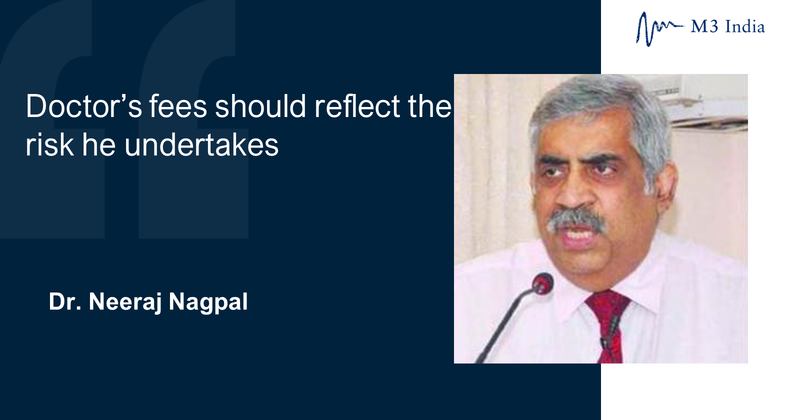Doctor's fees should reflect the risk he undertakes: Dr. Neeraj Nagpal
M3 India Newsdesk Feb 14, 2019
Dr. Neeraj Nagpal, a noted gastroenterologist and the convener of MLAG (medio-legal action group) explains why a doctor's consultation charges should correspond to the amount of risk he/she takes.

My Consultation Fee is Rs. 500, Rs. 800, and Rs. 2500
A professional’s fee for services depends on the type of work done. For extremely high-risk work, obviously, higher charges are mandated. A doctor doing high-risk surgery where life is at risk consequently charges more. However, there is another type of risk doctors undertake which is independent of the disease of a patient.
It is the differential monetary compensation claim which could arise from treating patients of different socioeconomic groups. So the question arises-
How should doctors charge their patients?
If their professional fee is to be linked to the risk involved then it is important to first understand what that risk might be. Since we are currently discussing only the monetary aspect, we need to ask- what could an adverse judgment cost a medical practitioner? These costs are to be quantified in terms of the legal community to understand.
Pecuniary damages
- The physical damages which are awarded by courts in cases of alleged medical negligence. These have become astronomical given the current formula being used by the courts after the Kunal Saha Judgment i.e. [(70-age) x annual earnings] + 30% for inflation– (1/3rd) expenses.
To put into perspective, compensation awarded in case of the death of a 35-year-old person earning Rs. 50,000 pm or Rs. 6 lakhs per year would be approximately Rs. 2 crores. It can be argued that this would be paid by insurers but then how many doctors take indemnity insurance worth Rs. 2 crores in the first place? And what if the person earns more than Rs. 50K per month?
- Unfortunately, the matter does not end here. Courts have also started awarding interest on the compensation awarded. This interest is variable and is dependent on the mood of the dispensing court.
Interest of 6 to 18% has been awarded in different judgments by different courts. This interest may then be awarded from 30 days after judgment till actual realisation of compensation or from the time the claim was originally filed. This discretion is independent of any guidelines or case law.
- The argument given for awarding this interest is that the claimant deserved to be compensated in 1997 when he originally filed the complaint. Hence the party which will now pay the compensation 15 years later has enjoyed the interest on the amount so should pay the interest to the claimant.
This argument has two flaws,
The maximum compensation that was ever awarded in 1997 was Rs. 17 lakhs in the Harjot Ahluwalia vs Springmeadows Hospital case. Even the Supreme Court did not award compensation of more than Rs. 1 crore till 2009 in the Prashant Dhanaka vs Nizam Institute of Medical Sciences case.
So there was no way that any court in its wisdom in 1997 would have given an award of Rs. 11.6 crores including interest. Any award given in 1997 would have been much less hence the question of benefitting from the interest on an unpaid award in crores does not arise.
The insurers if any would have had to pay the compensation even if Rs. 6 crores was awarded in 1997. Instead, if Rs. 6 crores was awarded in 2013, then the advantage of interest accrued was to the insurance firm and not to the hospital. However, even if the hospital was insured for Rs. 6 crores in 1997 the insurers would pay only Rs. 6 crores in 2013 as the limit of their policy and force the hospital to shell out the interest component.
- Pecuniary damages also need to include the loss of work and earnings during the time spent in preparing for the court case and in court, the legal fee.
Non-Pecuniary Damages
- Damages in terms of loss of reputation
- Damages in terms of mental agony
- Damages in terms of future patient/revenue
Under the circumstances am I justified in charging different rates to different patients?
If I am at increased risk of being sued for a higher amount because the person is rich then why should I not charge him more in the first place?
The Clinical Establishment Act mandates that I display my rates outside my chamber. So should I display different rate slabs for different income groups outside my chamber as follows?
| Income of patient | Consultation fee |
| Less than Rs. 2 lakhs per annum | Rs. 500 |
| Rs. 2 to 6 lakhs per annum | Rs. 800 |
| Rs. 6 to 10 lakhs per annum | Rs. 2500 |
Disclaimer- The views and opinions expressed in this article are those of the author's and do not necessarily reflect the official policy or position of M3 India.
-
Exclusive Write-ups & Webinars by KOLs
-
Daily Quiz by specialty
-
Paid Market Research Surveys
-
Case discussions, News & Journals' summaries